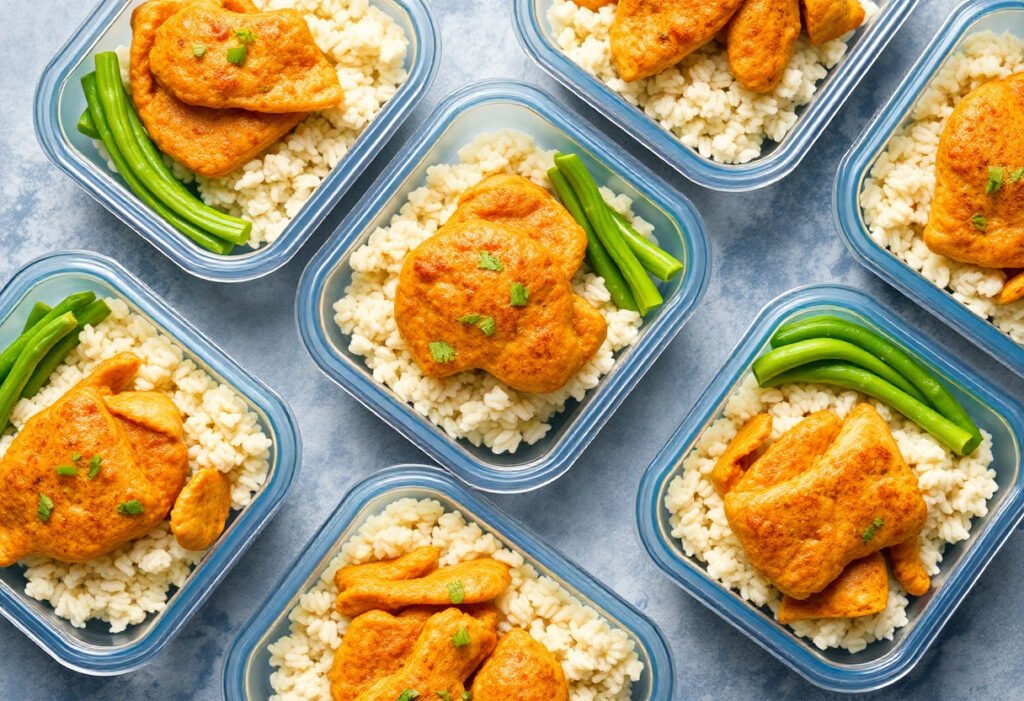Crafting meals that support fitness goals and promote overall well-being is an art in itself, and high-protein meal prep plays a crucial role in achieving these objectives. Chicken and rice form a nutritious foundation rich in essential proteins, adaptable to a variety of delicious, healthy recipes. This guide will walk you through mastering meal prep by exploring optimal chicken and rice selections, enriching marinades, efficient cooking techniques, and effective storage solutions. By balancing meals with vegetables and perfecting portion sizes, you can simplify your routine while ensuring each meal is both satisfying and beneficial.
Key Takeaways
- Mastering chicken and rice meal prep enhances nutritional intake by providing a high-protein foundation ideal for balanced diets.
- Flexibility in choosing chicken cuts and rice varieties allows for diverse meal options that cater to individual taste preferences and dietary needs.
- Combining proper marinating and cooking techniques with vegetables and spices elevates flavor without compromising nutritional value.
- Effective storage and portioning strategies ensure the longevity of meal prep, minimizing waste and maximizing efficiency.
- Awareness of common meal prep mistakes and how to avoid them ensures a seamless integration of this practice into daily routines.
The Benefits of High-Protein Meal Prep
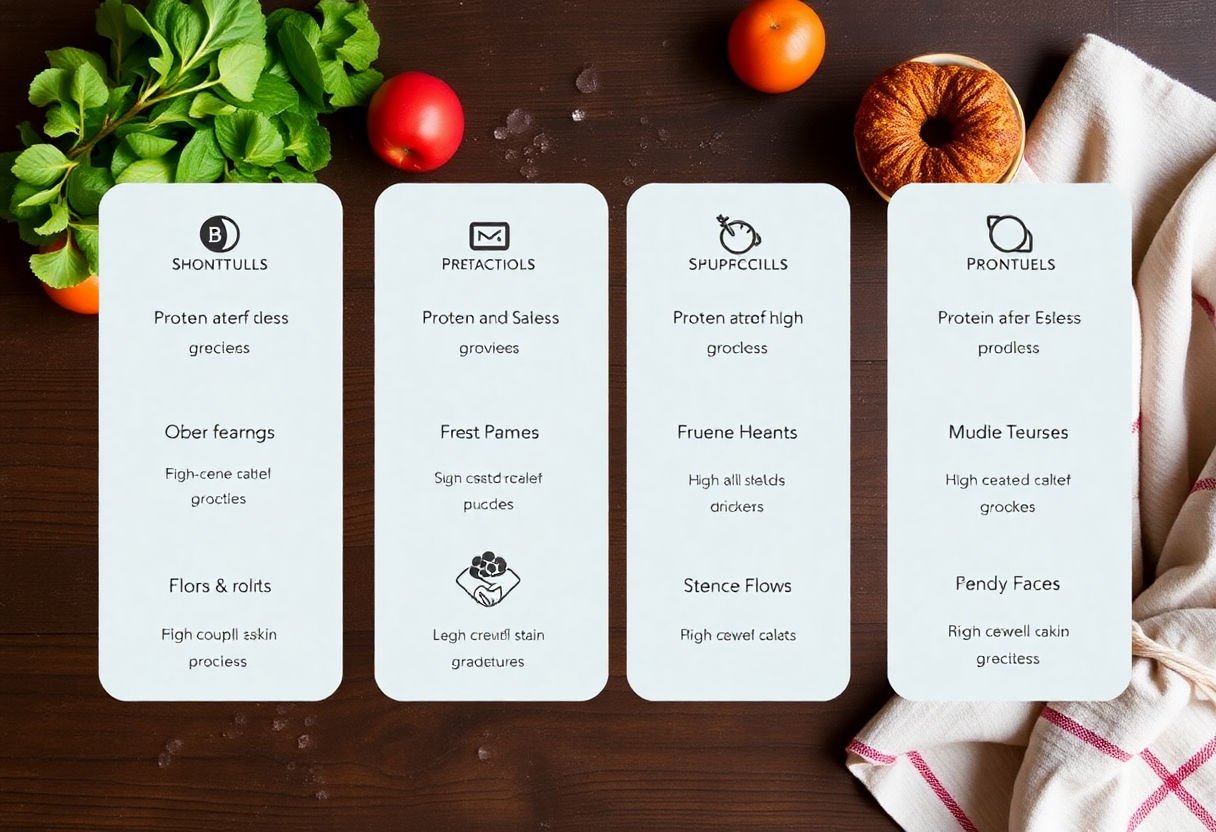
High-protein meal prep offers numerous benefits that extend beyond mere convenience. For individuals focusing on health and fitness, a protein-rich diet is crucial for maintaining muscle mass, aiding recovery, and promoting satiety. With chicken and rice forming a nutritious base, they provide a balanced intake of essential nutrients.
Muscle Maintenance and Growth: High-protein foods are indispensable for anyone engaged in strength training or regular exercise. Proteins are the building blocks of muscle tissue, crucial for both repair and growth. Incorporating high-protein meals ensures your body has a steady supply of the necessary amino acids.
Enhanced Metabolic Rate: Consuming protein can increase the thermic effect of food, which is the energy required to digest, absorb, and process nutrients. By boosting your metabolic rate, high-protein meal prep can aid in effective weight management.
Satiety and Appetite Control: Protein is known for its ability to increase feelings of fullness. This can be particularly beneficial for those trying to manage their calorie intake, as a protein-rich diet can help curb hunger and reduce the likelihood of overeating.
Convenience and Consistency: Preparing high-protein meals in advance not only saves time but also promotes dietary consistency. By streamlining your menu with pre-portioned meals, it becomes easier to adhere to nutrition goals without the hassle of daily meal planning.
Engaging in high-protein meal prep is not merely about sustenance but also about fostering a lifestyle that supports health, fitness goals, and overall well-being. By prioritizing protein intake, you lay a strong foundation for a balanced and nutritious diet.
Choosing the Right Chicken and Rice
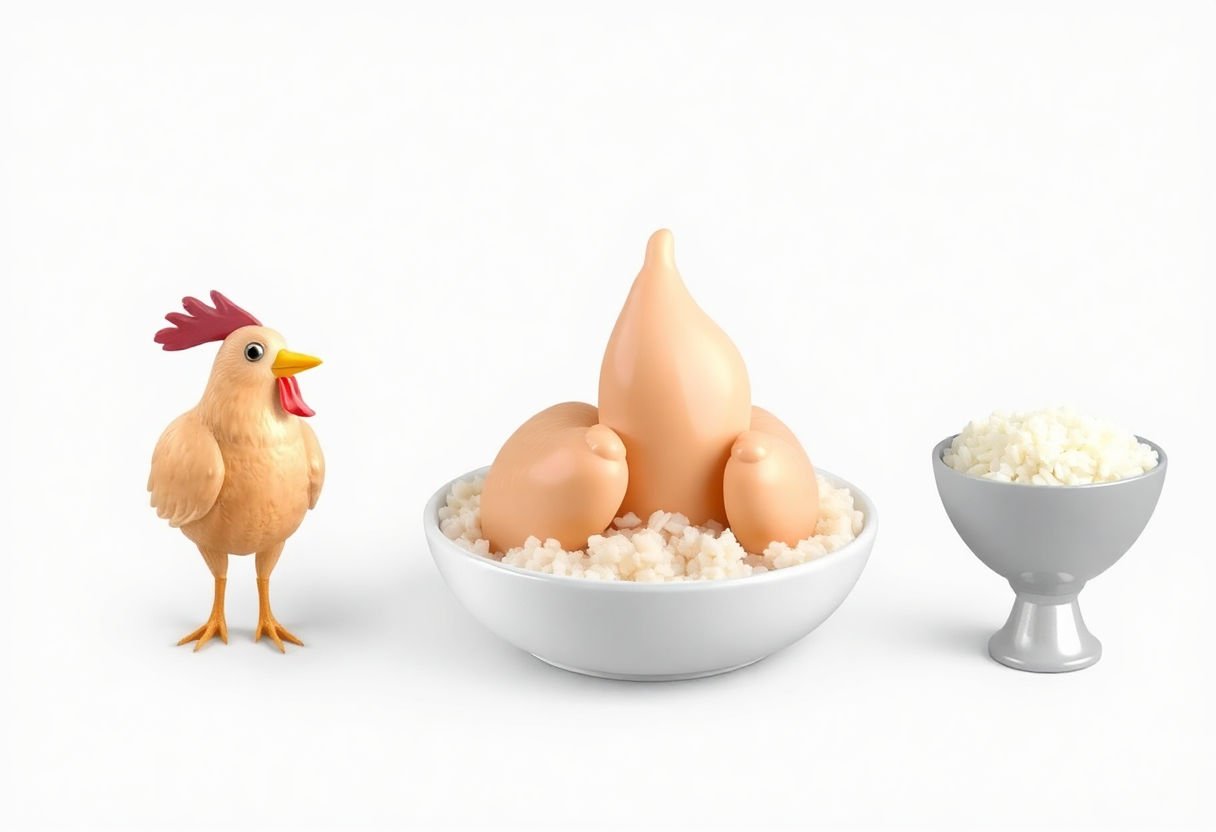
Selecting the most suitable chicken and rice is crucial to crafting a nutritious, high-protein meal prep plan. When it comes to chicken, opting for the right cut can make a significant difference in both flavor and nutritional value. Chicken breast is a popular choice due to its low fat content and high protein percentage. With approximately 31 grams of protein per 100 grams, chicken breast is ideal for those prioritizing lean muscle growth. Alternatively, chicken thighs may offer more flavor and tenderness, thanks to a slightly higher fat content, making them a preferred option for those seeking richer taste.
For rice, diverse varieties cater to different culinary and nutritional preferences. Brown rice is often lauded for its higher fiber content and additional nutrients compared to its white counterpart. This whole grain variety aids in digestion and provides a sustained energy release. In contrast, white rice offers a softer texture and quicker cooking time, which can be more convenient for meal prepping. Basmati and jasmine rice are fragrant alternatives that infuse your meals with aromatic flavors, enhancing the dining experience without additional calories.
Ultimately, the choice between these options depends on personal goals and taste preferences. Consider incorporating a mix of chicken cuts and rice types to keep your meal prep both satisfying and nutritionally balanced. Aim to match the right cut of chicken with your choice of rice to create a harmonious blend of flavors and nutrients, tailored to your dietary requirements and taste buds.
Marinating and Seasoning Techniques
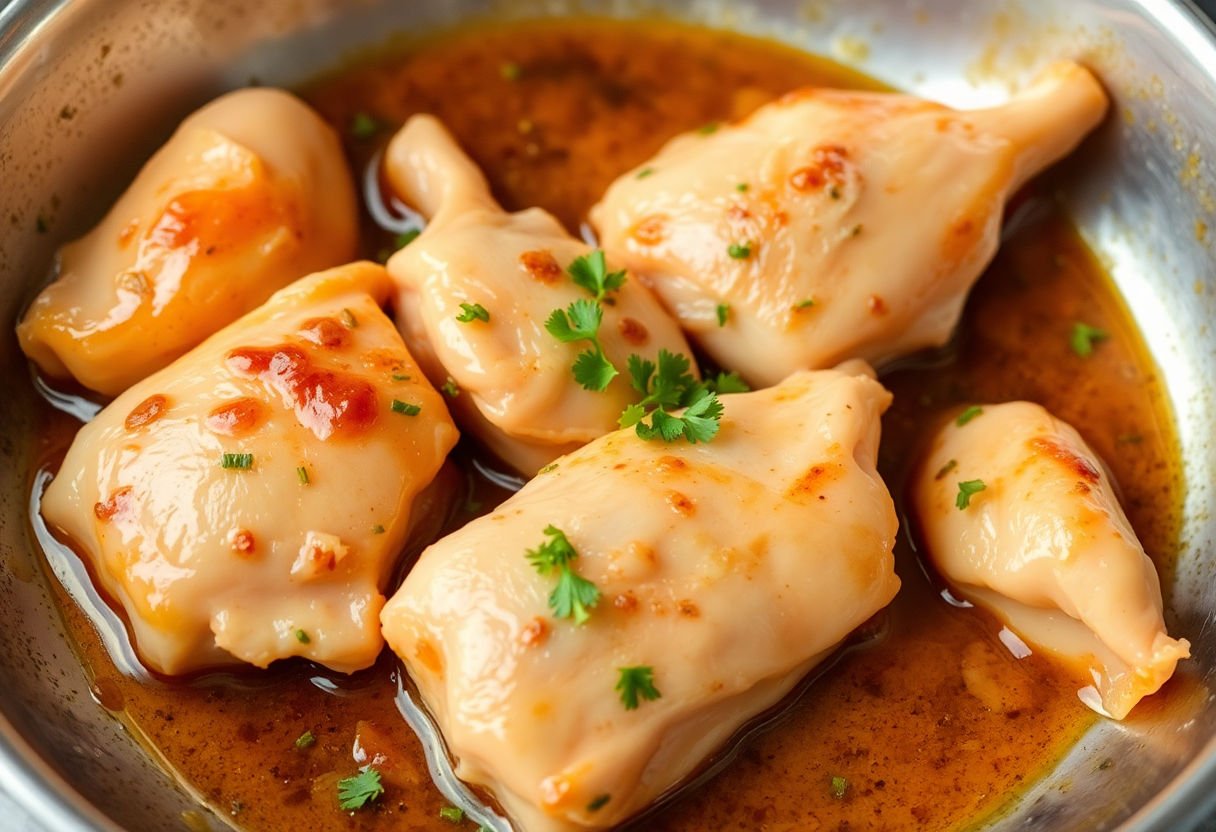
Marinating and seasoning are fundamental techniques to elevate the flavor profile of high-protein chicken dishes. Marinades serve as both flavor enhancers and tenderizers. A basic marinade includes an acid such as lemon juice or vinegar, oil, and seasonings. Consider adding garlic, ginger, and soy sauce for an Asian-inspired twist, or opt for olive oil, lemon, and oregano for Mediterranean flavors. For effectively marinating chicken, allow it to soak in the mixture for a minimum of two hours, preferably overnight, allowing the flavors to deeply penetrate.
Dry rubs offer an alternative to marinades, consisting of a mix of herbs and spices that are massaged directly onto the meat. Common ingredients might include paprika, cumin, garlic powder, and thyme. Dry rubs are excellent for quick preparation and give the chicken a robust, crusty exterior when cooked.
When seasoning rice, a touch of salt and pepper can be enhanced with a pinch of saffron or turmeric for color and subtle earthiness, or perhaps coconut milk and cilantro for a richer, tropical flair. It is essential to maintain balance; season adequately but avoid overpowering the natural flavors of the chicken and rice.
“In cooking,” remarked the French chef Auguste Escoffier, “success is not achieved with a single magnificent dish, but with the harmonious balance of flavors and textures.” Adhering to this philosophy, marinating and seasoning contribute to the art of crafting delicious high-protein meals that satisfy both the palate and nutritional goals.
Cooking Methods That Retain Protein
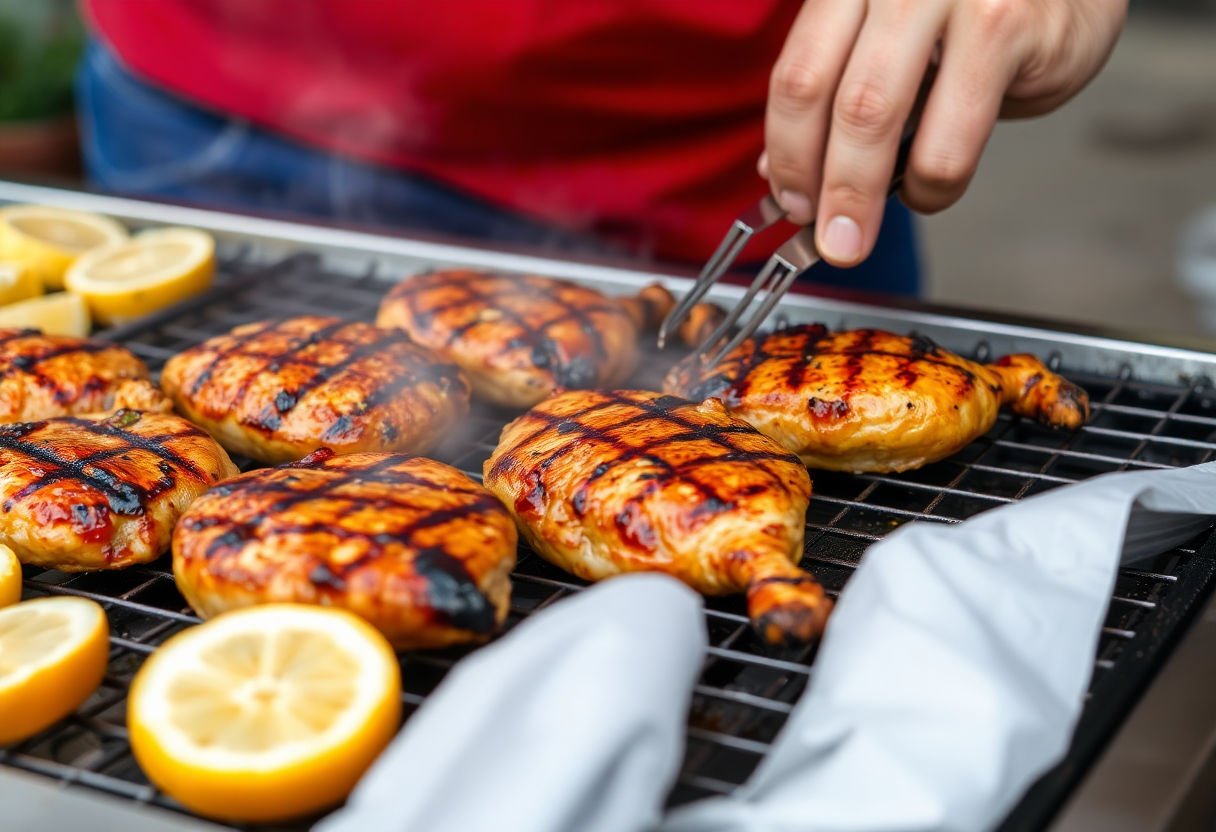
Maintaining the protein content in chicken and rice during cooking is vital for those focusing on high-protein meal prep. Different cooking methods can affect protein levels, so choosing the right technique is crucial.
Poaching is a gentle cooking method which involves simmering chicken in water or broth at a low temperature. This technique helps in preserving the protein content, resulting in tender and juicy chicken without significant nutrient loss. Poaching is advantageous as it requires minimal additional fats, keeping your meal light and healthy.
Grilling chicken is another favorable method. It sears the meat quickly, locking in juices while maintaining the protein structure. To grill effectively, preheat the grill to ensure that the chicken cooks evenly without drying out. Keep in mind, though, to avoid over-charring, as it may lead to the formation of potentially harmful substances without protein loss benefits.
Steaming rice is an effective way to cook it while capturing nutrients, as there is minimal nutrient loss compared to boiling. This method allows rice to retain its protein and other beneficial nutrients, offering a more wholesome component to your meal prep.
Finally, employing a pressure cooker can enhance both efficiency and nutrient retention. This method uses steam under high pressure, significantly reducing cooking time while helping to preserve essential proteins in both chicken and rice. It is particularly beneficial for individuals looking to maximize nutrition with limited time for meal preparation.
Balancing Meals with Vegetables and Spices
Incorporating a variety of vegetables and spices into your chicken and rice meal prep not only enhances the flavor but also significantly boosts the nutritional value of your meals. Vegetables provide essential vitamins, minerals, and fiber, complementing the high-protein base of chicken and rice.
To achieve a well-balanced meal, aim to include a spectrum of colors by selecting vegetables such as:
- Broccoli, known for its high vitamin C content and fiber.
- Bell peppers, rich in antioxidants and vitamin A.
- Carrots, offering beta-carotene and potassium.
- Spinach, providing iron and calcium in abundance.
In addition to vegetables, spices play a crucial role in transforming your meals from bland to extraordinary. Spices such as turmeric, cumin, and paprika not only add depth to the flavor profile but also come packed with health benefits. For instance, turmeric contains curcumin, known for its anti-inflammatory properties, while cumin aids digestion.
When integrating spices, consider:
- Making your own spice blends to tailor flavors to your preference.
- Starting with small quantities to avoid overpowering the dish.
- Experimenting with combinations to find unique and delightful flavors.
Creating balance in your meals also means understanding proportions. Strive for a plate that consists of:
- 40% vegetables
- 30% lean protein (chicken)
- 30% whole grains (rice)
This balance not only ensures variety but also aligns with dietary guidelines for optimal health. By thoughtfully balancing vegetables and spices with your chicken and rice, you craft meals that are not only nourishing but also fulfill a broad spectrum of taste preferences.
Storage Solutions for Optimum Freshness
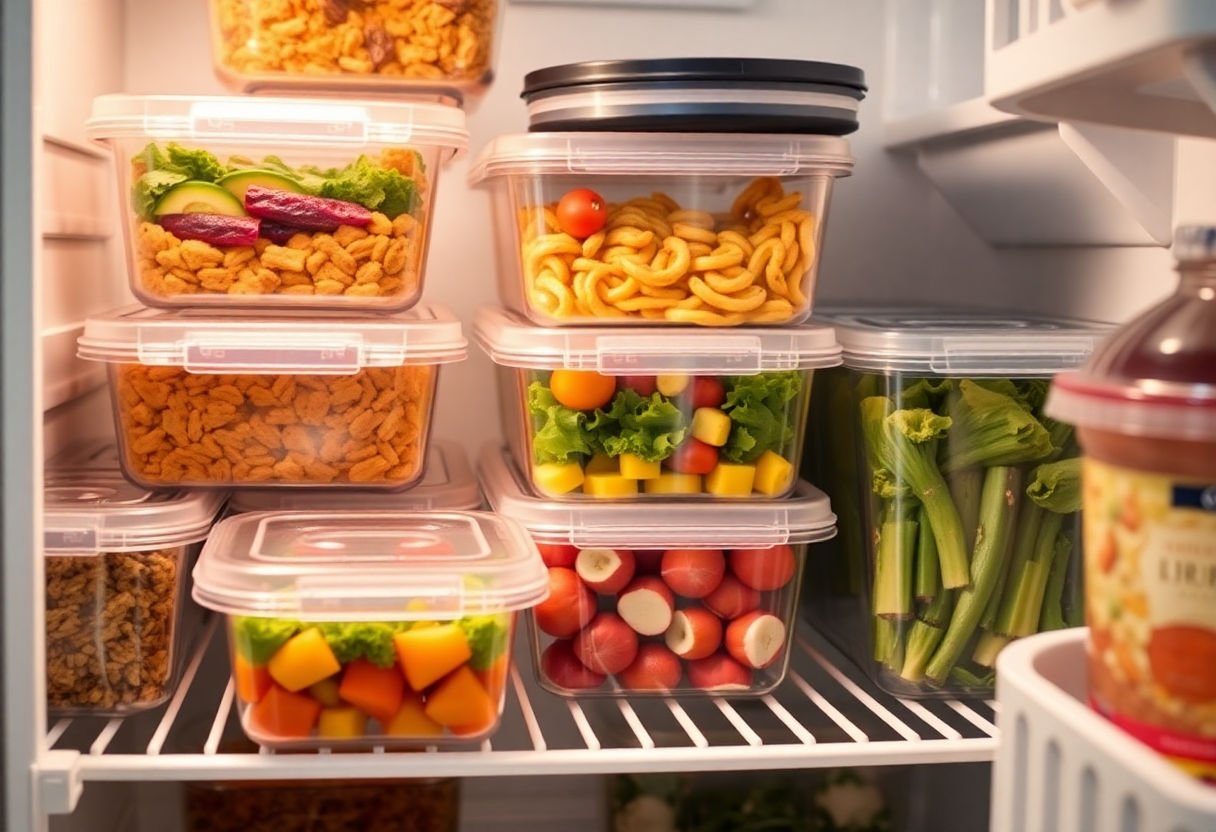
To ensure the longevity and optimum freshness of your high-protein chicken and rice meal prep, utilizing effective storage techniques is crucial. This not only preserves flavor but also maintains nutritional integrity.
Refrigeration: For short-term storage, place your prepared meals in airtight containers and refrigerate them promptly. Ensure your refrigerator is set at or below 40°F to prevent bacterial growth. Meals are best consumed within four days.
Freezing: For long-term storage, freezing is an excellent option. Portion your meals into individual servings and store them in freezer-safe containers or bags. Expel as much air as possible to prevent freezer burn. When properly stored, meals can last for up to three months in the freezer.
Container Choices: Select containers that are BPA-free and designed specifically for storing food. Glass containers with snap-lock lids are ideal as they are non-reactive and can be used in the microwave. However, high-quality plastic options are also available.
Labeling: Always label your meals with the preparation date and contents. This practice aids in tracking freshness and planning consumption effectively.
Defrosting: When ready to consume, defrost meals in the refrigerator overnight. Avoid leaving them at room temperature as this can lead to unsafe bacteria levels. For rapid defrosting, utilize the microwave’s defrost setting.
Implementing these storage solutions will allow you to enjoy fresh, high-protein chicken and rice meals at your convenience, ensuring your meal prep efforts remain both effective and enjoyable.
Meal Prep Schedules and Portioning
Efficient meal prep begins with a well-structured schedule. Allocate a specific day and time each week dedicated to preparing your high-protein chicken and rice meals. This routine not only optimizes your time but also ensures consistent nutritional intake, aligning with fitness goals or dietary needs.
Portioning is crucial for balanced nutrition and calorie control. Consider your daily protein requirements, which typically range from 46 to 56 grams per day for adults, according to dietary guidelines. Divide your chicken and rice into servings that meet these requirements. For example, a typical portion could include 4 ounces of cooked chicken breast mixed with 1 to 1.5 cups of cooked rice.
To bring variety and nutritional balance to your meals:
- Pair each serving with a variety of vegetables such as broccoli, spinach, or bell peppers, which add essential vitamins and minerals.
- Season with herbs and spices like turmeric or cayenne pepper to enhance flavor without added calories.
Consider using a meal prep container with partitions to keep chicken, rice, and vegetables separate until consumption, preserving flavor and texture. Labeling containers with the date and content helps maintain organization and prevent food wastage.
Implementing a rotation plan ensures you enjoy diverse flavors each week while maintaining nutritional integrity. Prepare different marinades or spice mixes to apply to your chicken, ensuring a fresh taste experience every day. By following these strategic scheduling and portioning tips, you streamline your meal prep process and enhance your dietary regimen with efficiency and taste.
Common Mistakes and How to Avoid Them
To achieve success in high-protein chicken and rice meal prep, it’s crucial to avoid common mistakes that could compromise nutritional goals, taste, and efficiency. Here are some pitfalls to recognize and strategies to overcome them:
Overcooking Chicken: Overcooking can lead to dry, tough chicken that is unappetizing. To prevent this, use a meat thermometer and cook chicken until it reaches an internal temperature of 165°F. Additionally, applying marinades can help maintain moisture.
Improper Rice Texture: Achieving the right texture of rice is essential. Avoid mushy or undercooked rice by following the recommended water-to-rice ratio for the type you choose. Consider cooking rice separately and taste testing before portioning.
Imbalance in Macronutrients: While emphasizing protein, it’s easy to neglect balanced macronutrients. Incorporate a variety of vegetables and healthy fats to ensure meals deliver comprehensive nutrition. Adding leafy greens or steamed vegetables can round out the plate.
Neglecting Portion Control: Without adequate portioning, it’s easy to overeat or consume insufficient nutrients. Use a kitchen scale to weigh portions, especially when managing calorie intake for fitness goals.
Skipping Meal Variety: Repeating the same meals can lead to culinary fatigue. Rotate seasonings, sauces, and side ingredients to introduce variety without straying from health objectives.
Inadequate Storage Practices: Improper storage can lead to spoilage and foodborne illness. Store meals in airtight containers and label them with preparation dates. Aim to consume all prepped meals within 3 to 4 days, or freeze them for extended freshness.
By recognizing and addressing these potential issues, meal prep becomes a more efficient and enjoyable process, promising flavorful and nutritious high-protein chicken and rice dishes.
Conclusion
Mastering the art of high-protein chicken and rice meal prep requires careful selection of ingredients, thoughtful preparation techniques, and practical storage solutions. By choosing the right chicken cuts and rice, and employing effective marination and cooking methods, you can ensure nutrient-rich and flavorful meals. Incorporate a variety of vegetables and spices to maintain a balanced diet. Adhering to these strategies not only optimizes your nutritional intake but also simplifies your weekly routine, fostering a sustainable healthy lifestyle. As you perfect these skills, the efficiency and satisfaction of meal prep will profoundly support your health and fitness goals.
Frequently Asked Questions
How long does chicken and rice meal prep last in the refrigerator?
Properly stored in airtight containers, chicken and rice meal preps can last up to four days in the refrigerator, ensuring food safety and freshness.
How can I ensure my meal prep retains its flavor over several days?
To maintain flavor, use robust marinating and seasoning techniques before cooking and consider reheating meals gently to preserve taste.
Is it necessary to vary the types of chicken cuts in my meal prep?
While not necessary, using different chicken cuts, such as breasts, thighs, or drumsticks, can add variety in texture and flavor to your meal plan.
What is the best way to reheat prepared chicken and rice?
Reheat meals using a microwave or stovetop on low to medium heat, adding a splash of water or broth to maintain moisture and prevent drying.
Can high-protein chicken and rice meal prep support my fitness goals?
Yes, incorporating high-protein chicken and rice in your meal prep can provide essential nutrients and energy, supporting muscle repair and growth as part of a balanced fitness regimen.
